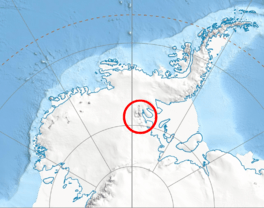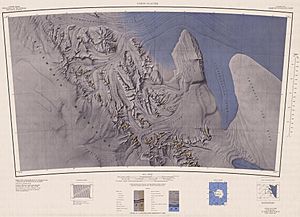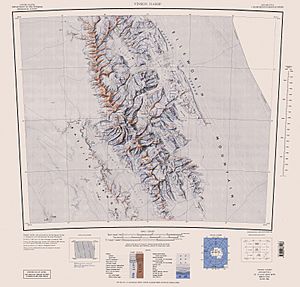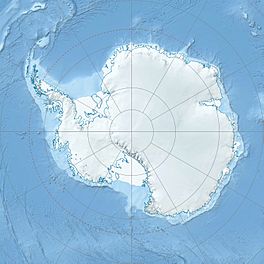Minnesota Glacier facts for kids
Quick facts for kids Minnesota Glacier |
|
|---|---|

Location of Ellsworth Mountains in Western Antarctica
|
|
| Location | Ellsworth Land |
| Coordinates | 79°00′00″S 83°00′00″W / 79.00000°S 83.00000°W |
| Length | 40 nautical miles (74 km; 46 mi) |
| Width | 5 nautical miles (9.3 km; 5.8 mi) |
| Thickness | unknown |
| Terminus | Rutford Ice Stream |
| Status | unknown |


The Minnesota Glacier (79°0′S 83°0′W / 79.000°S 83.000°W) is a very large glacier located in Antarctica. It is about 40 nautical miles (74 km; 46 mi) (74 kilometers) long and 5 nautical miles (9.3 km; 5.8 mi) (9.3 kilometers) wide. This huge river of ice flows towards the east through the Ellsworth Mountains. It helps separate two important mountain ranges: the Sentinel Range and the Heritage Range.
This glacier gets its ice from a high, flat area (a plateau) located west of the mountains. It also receives ice from other glaciers like the Nimitz Glacier and the Splettstoesser Glacier. Eventually, the Minnesota Glacier joins an even bigger ice stream called the Rutford Ice Stream at the eastern edge of the Ellsworth Mountains.
Naming the Glacier
The Minnesota Glacier was given its name by the Advisory Committee on Antarctic Names. This group is in charge of naming places in Antarctica. They chose the name to honor the University of Minnesota, Twin Cities.
The university sent several research teams to the Ellsworth Mountains. These teams explored the area during the summers of 1961–62, 1962–63, and 1963–64. Naming the glacier after the university was a way to recognize their important scientific work.
Other Glaciers Nearby
The Minnesota Glacier is part of a large system of ice and mountains. Many smaller glaciers flow into it or are located nearby. These are sometimes called "tributary glaciers" because they contribute ice to the main glacier, much like small rivers flow into a larger river.
Here are some of the glaciers that are connected to or near the Minnesota Glacier:


